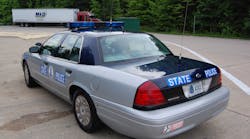Several state departments of transportation are planning a multi-pronged highway safety enforcement blitz this week to coincide with the heavy roadway travel expected for the Thanksgiving holiday weekend.
The Pennsylvania Department of Transportation (PennDOT) in conjunction with local police departments across the Keystone state are joining forces to conduct "Operation Safe Holiday" this week: an initiative including seat-belt, aggressive-driving and impaired-driving enforcement.
PennDOT Secretary Barry Schoch said this operation is already under way, beginning with statewide Click It or Ticket seat-belt enforcement. Through the Christmas and New Year holidays, he said Pennsylvania police will also use sobriety checkpoints, roving patrols and regular traffic safety patrols to crack down on motorists who are speeding, driving aggressively or driving while impaired by drugs or alcohol.
"Every year we see an increase in travel during the holiday season, and unfortunately we also see more crashes," Schoch noted. "If we all take the simple steps to buckle up, take our time and drive safe and sober, the holidays will be safer for everyone on Pennsylvania's roadways."
PennDOT data indicates that the holidays continue to be the leading time period for traffic crashes. For example, Schoch pointed out that there were 4,235 crashes and 49 fatalities last year during the Thanksgiving travel period, which includes the weekends before and after the holiday. During the Christmas and New Year travel periods, there were a combined 1,994 crashes and 19 fatalities.
Indeed, AAA (formerly the American Automobile Association) projects 43.6 million Americans will journey 50 miles or more from home during the Thanksgiving holiday “weekend” – running from Wednesday, Nov. 21 to Sunday, Nov. 25 – which is an increase of 0.7% over the 43.3 million people that traveled during Thanksgiving in 2011.
This increase marks the fourth consecutive year of growing holiday travelers since 2008 when Thanksgiving travel fell by 25%, and the group noted that roughly 90% of all Thanksgiving holiday travelers – equating to 39.1 million people – will travel by automobile, an increase of 0.6% over 2011.
“Thanksgiving travel hit a decade low in 2008 when only 37.8 million Americans traveled,” noted AAA President and CEO Robert Darbelnet. “But since that year we have seen a steady increase in the number of travelers taking to the roads and skies for the holiday.”
North Carolina is another state that plans a highway safety push over the holidays, as it noted 397 unbuckled motorists died in crashes on its roads last year.
In an effort to reduce such fatalities, the N.C. Department of Transportationis launching a statewide Thanksgiving “Click It or Ticket” campaign to crack down on motorists who are not wearing their seat belts.
“We want everyone to make it home safely, not only during the holidays, but all year long,” noted Gene Conti, North Carolina’s transportation secretary. “So buckle up, and make sure your passengers are buckled up also.”
In 2011, he said, the Research Triangle Institute reported that North Carolina’s seat belt usage rate topped 88.7% percent; a big increase from the usage rate of 65% when the program started in 1993.
North Carolina’s seat belt usage rate exceeds the 86% usage rate for the U.S. as a whole, according to the National Highway Traffic Safety Administration’s (NHTSA) new 2012 National Occupant Protection Use Survey released this week.
"When it comes to driving safely, one of the most effective ways to protect yourself and your family is to use a seat belt," said Transportation Secretary Ray LaHood. "This Thanksgiving holiday, we're urging everyone on our roadways to buckle up – every trip, every time."
NHTSA added that seat belt use has steadily increased since 1994, with the record high of 86% recorded this year representing a 2% increase over 2011. Among the most dramatic increases in seat belt use were in the southern region of the country, rising to 85% in 2012 — up from 80% in 2011.
Seat belt use continues to be higher in states that have primary belt laws, which permit law enforcement officers to issue citations to motorists solely for not using a seat belt rather than requiring additional traffic violations, added NHTSA Administrator David Strickland.
"Thanks to the ongoing work of our state and local partners and national efforts such as 'Click it or Ticket,' we've made steady gains in belt use in recent years," he pointed out. "Moving forward, it will be critical to build on this success using a multi-faceted approach that combines good laws, effective enforcement, and public education and awareness."
Nationwide, according to NHTSA’s data, 32 states and the District of Columbia have passed primary laws requiring seat belt use, while another 17 states have secondary laws on the books. New Hampshire is the only state that has not enacted either a primary or secondary seat belt law, the agency added, though the state's primary child passenger safety law applies to all drivers and passengers under the age of 18.
“Thus 18 states still lack critical primary seat belt laws and it’s these laws that allow law enforcement officers to ticket a driver or passenger for not wearing a seat belt, without any other traffic offense taking place,”noted Kendell Poole, chairman of the Governors Highway Safety Association (GHSA).
“If these states were to pass primary laws, they would likely experience a dramatic increase in seat belt use,” Poole added. “In 2011, NHTSA noted that states and territories with primary enforcement had observed front-seat occupant use rates 11 percentage points higher than states with secondary enforcement (87% vs. 76%).”
He also noted that increasing seat belt use will continue to be a focus for GHSA, as no other highway safety countermeasure has been proven to be as effective as the simple habit of buckling up.



